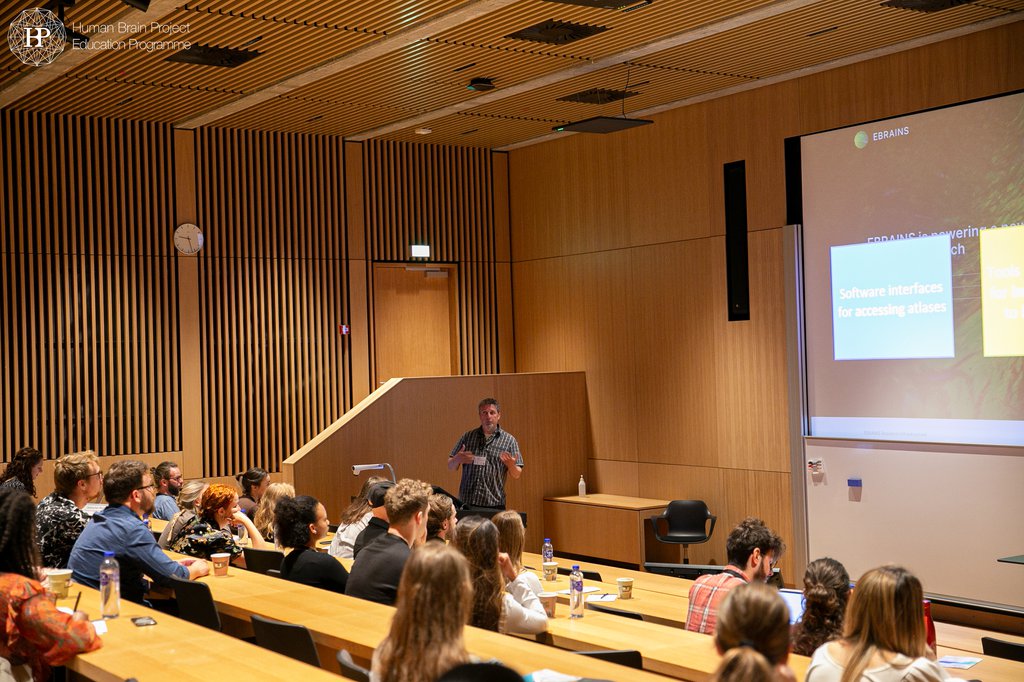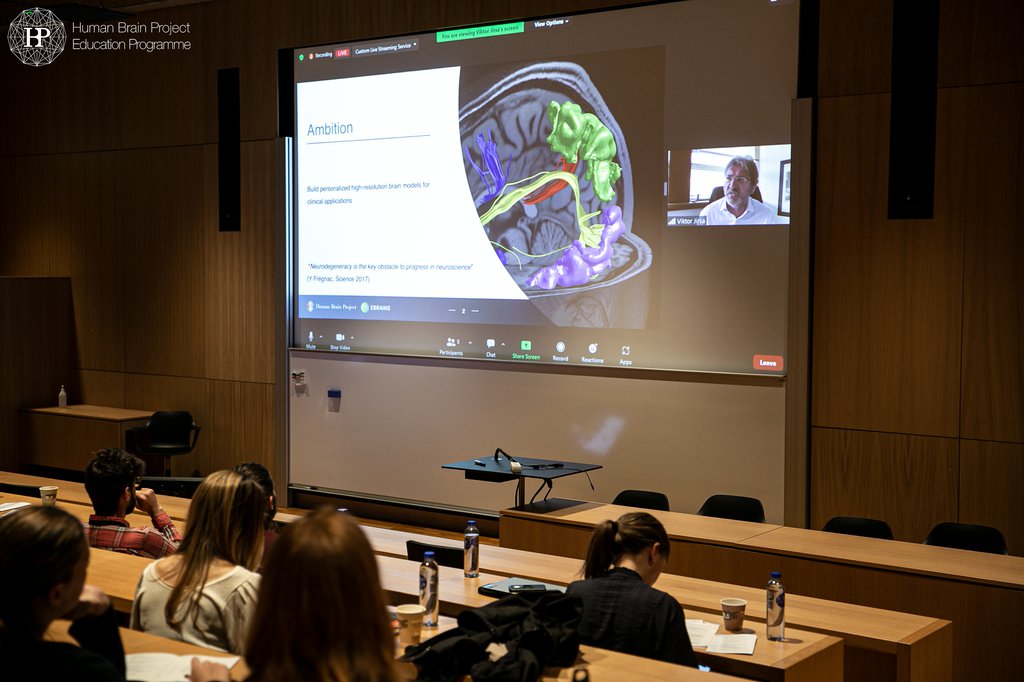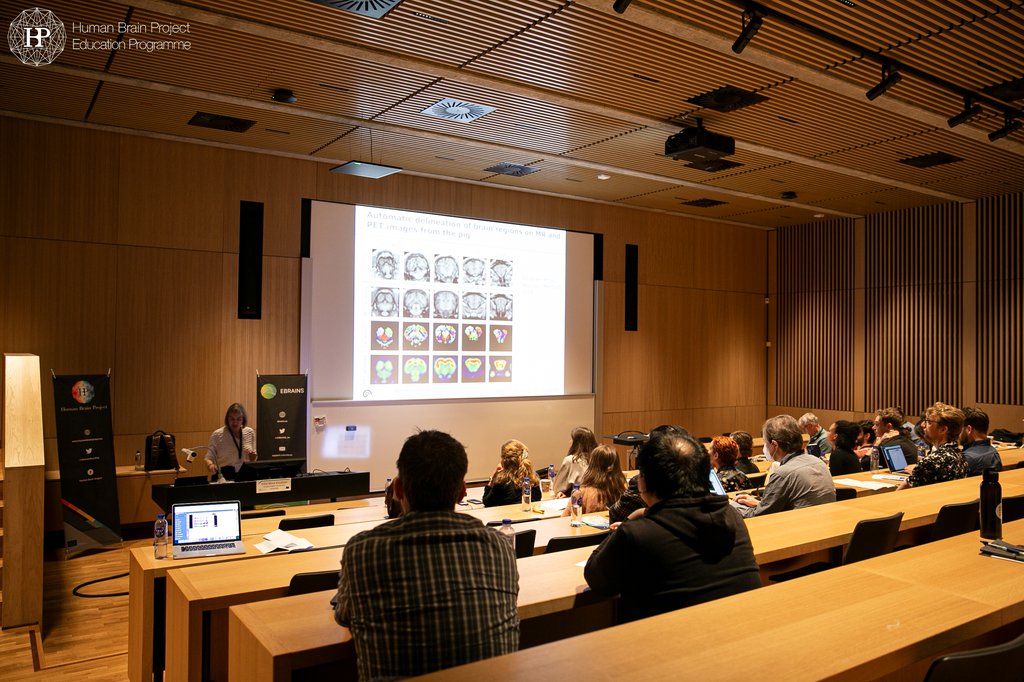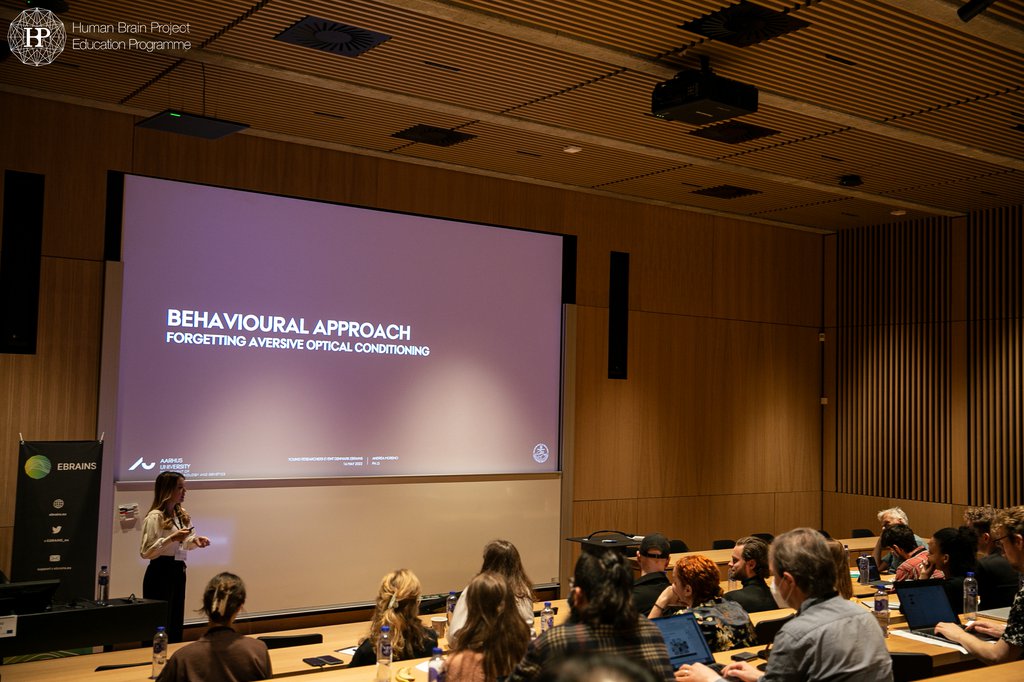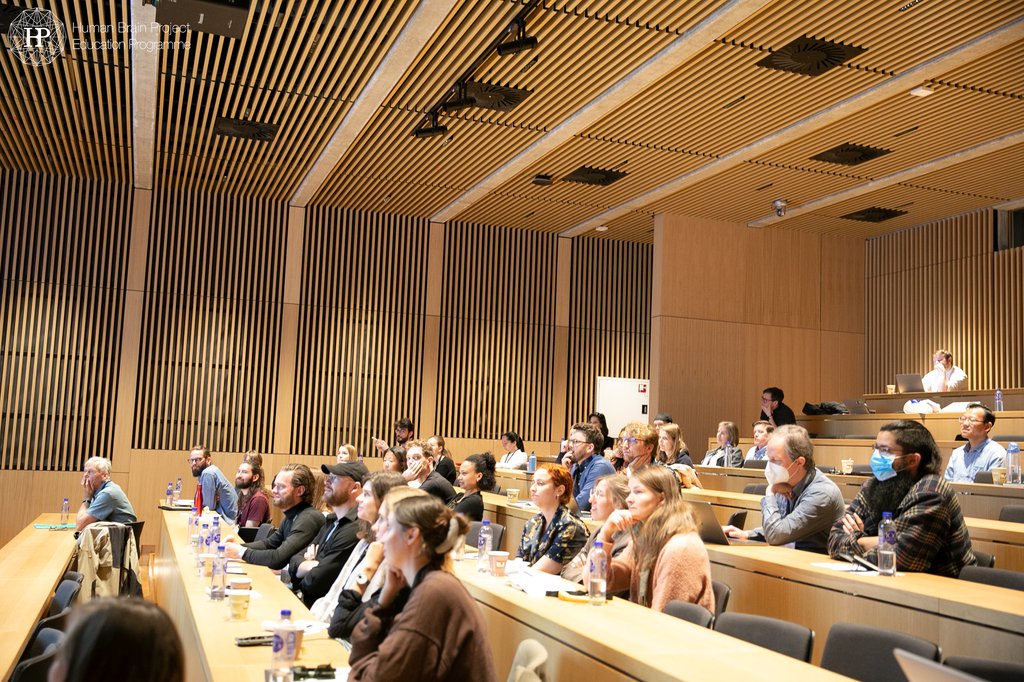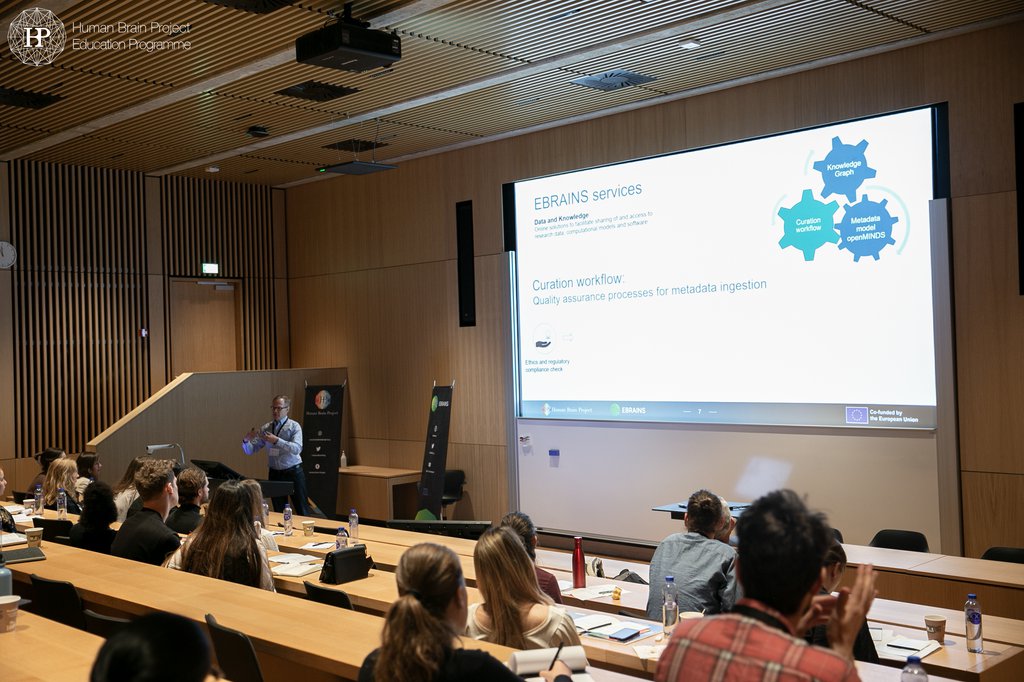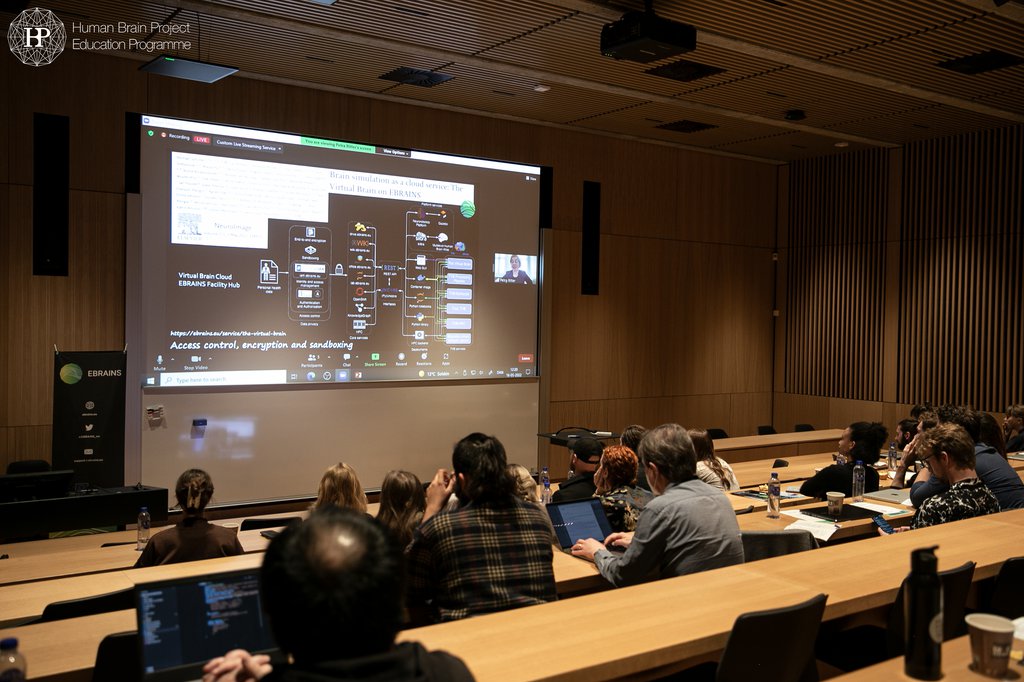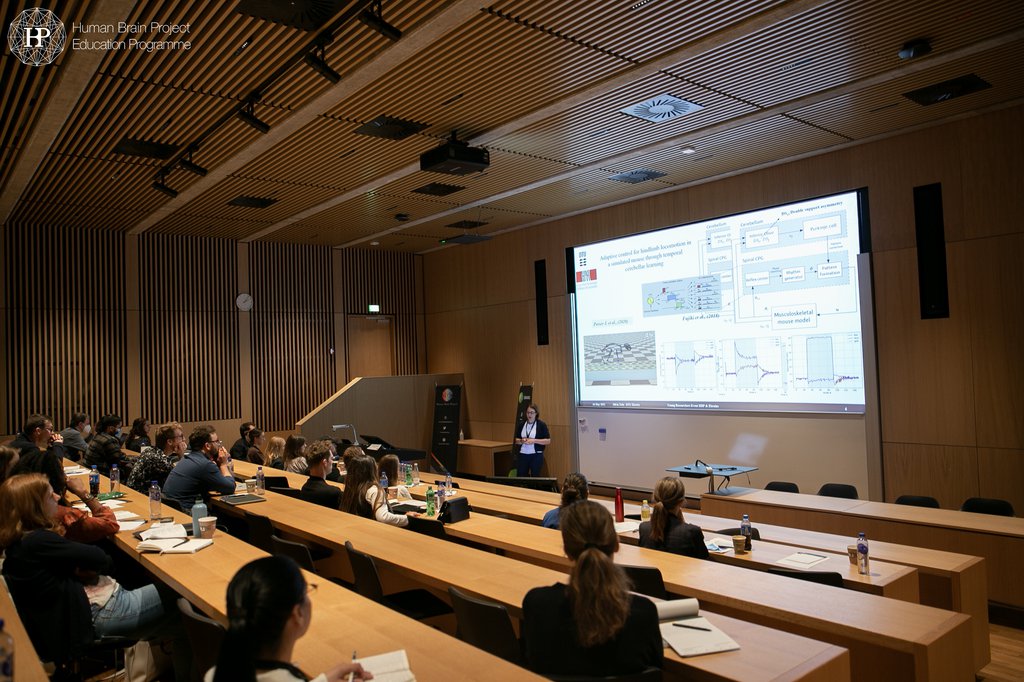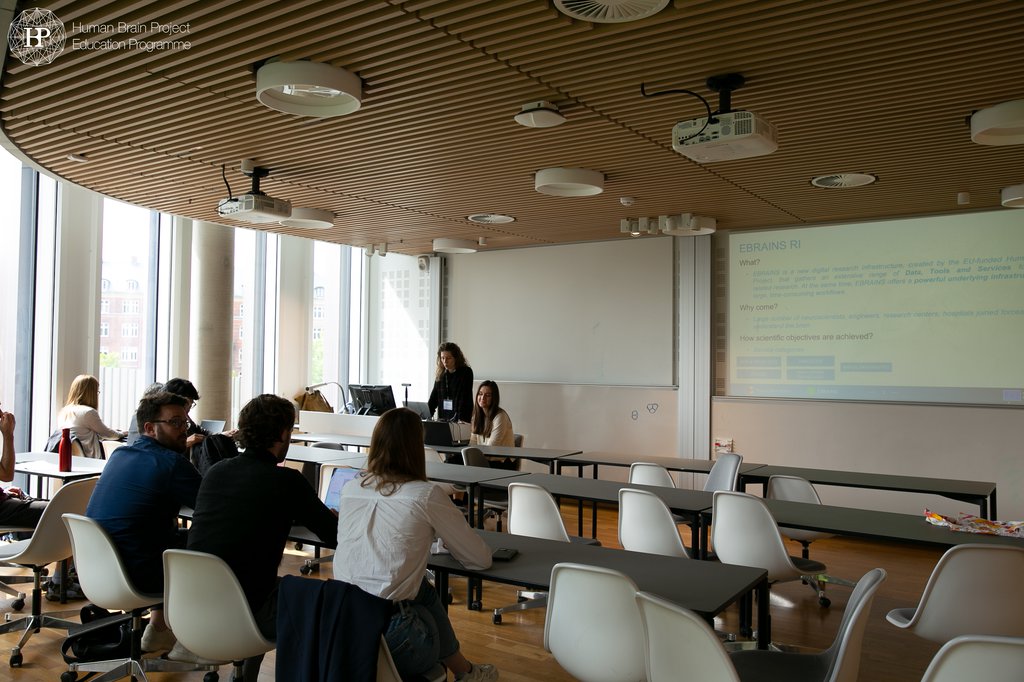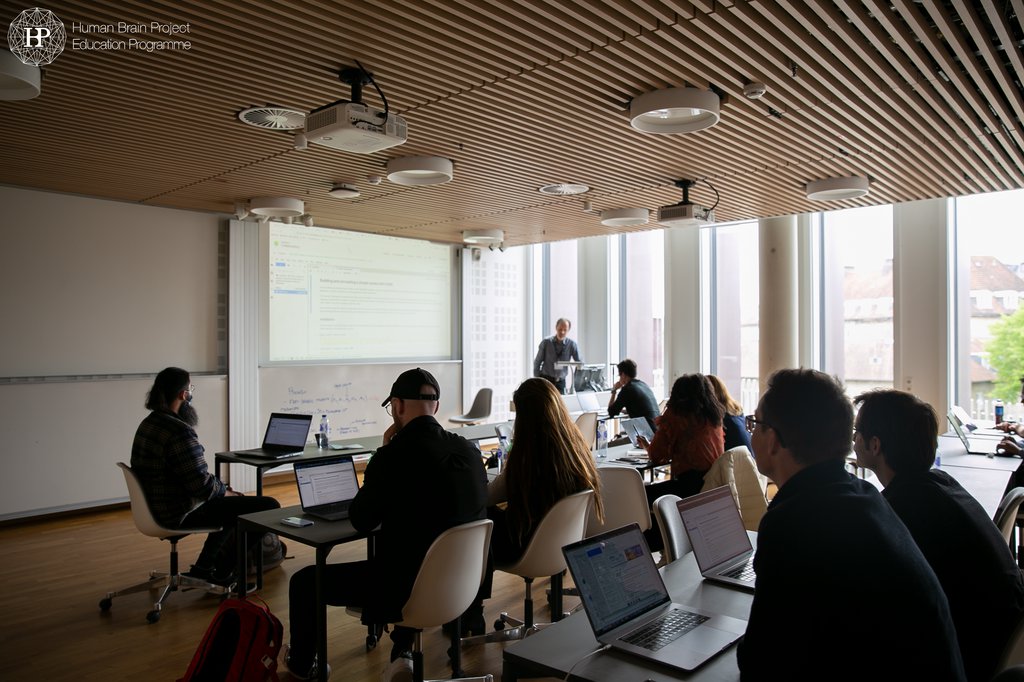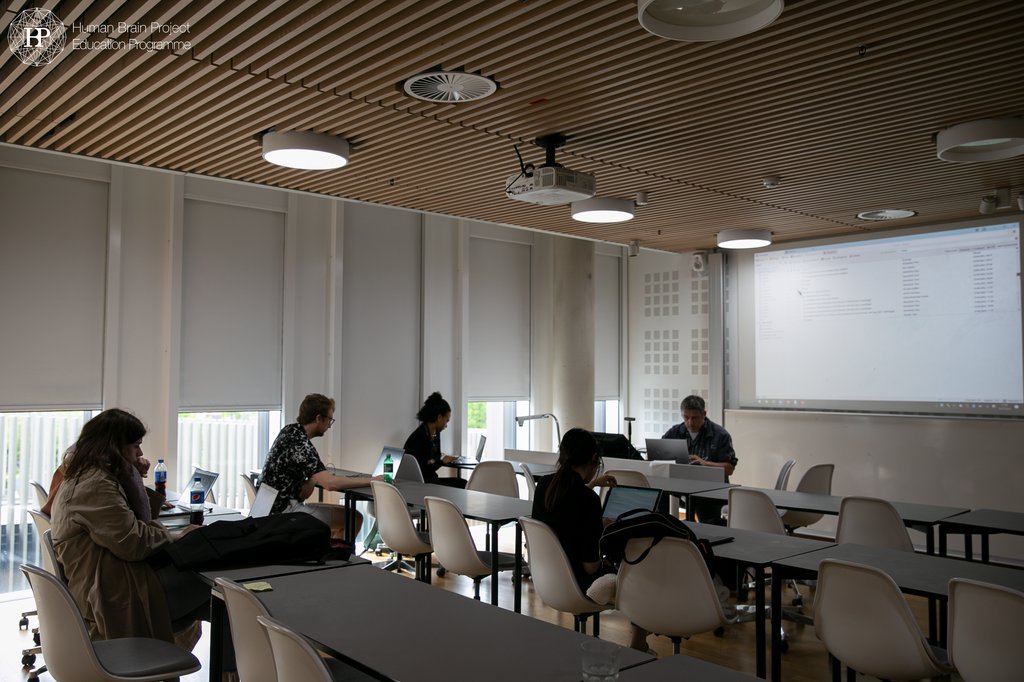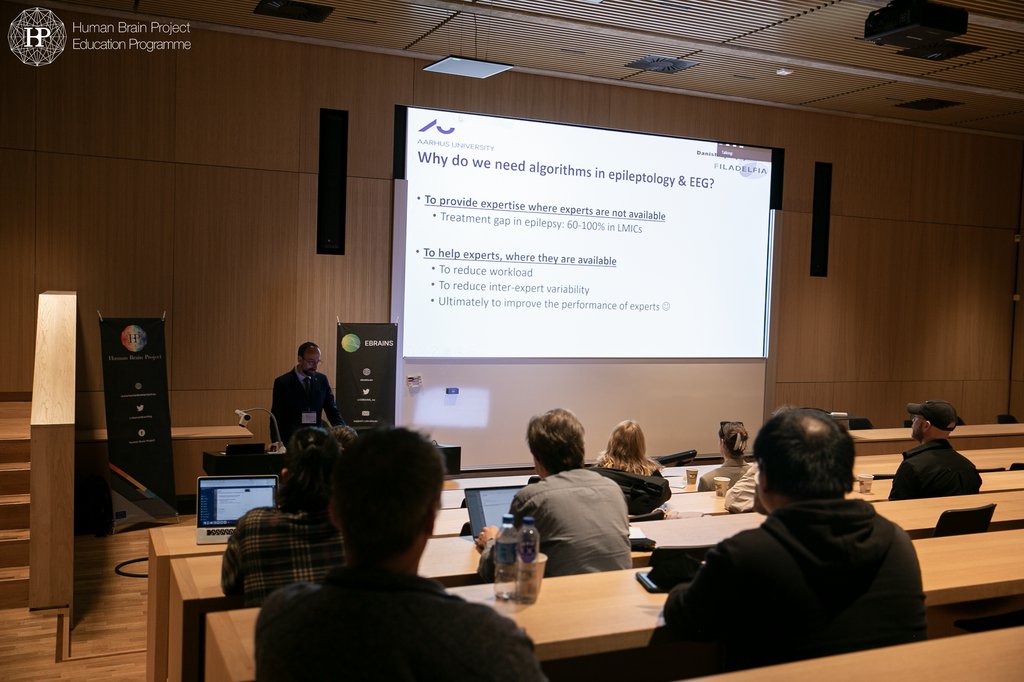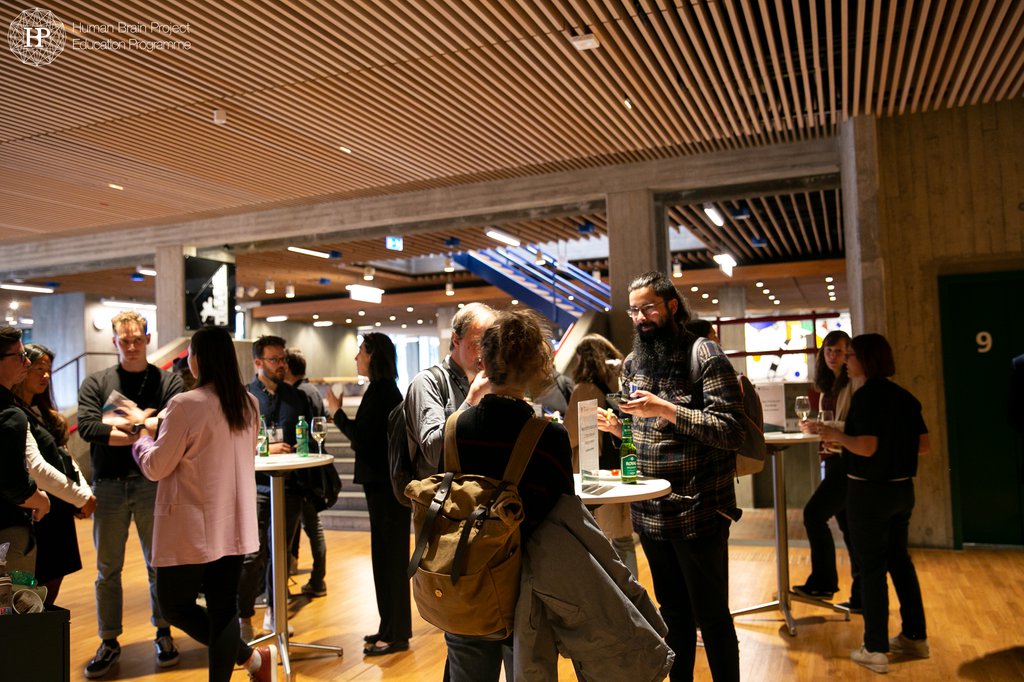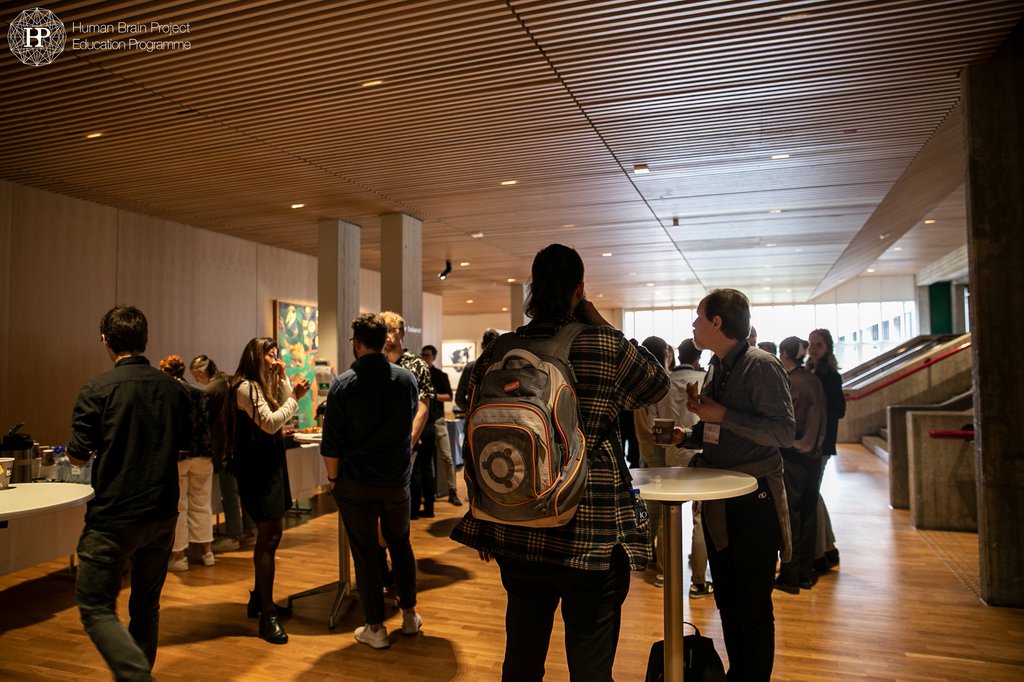Young Researchers Event
Young Researchers Event: EBRAINS - a digital European Infrastructure for next-generation basic & clinical neuroscience
16 May 2022 | Copenhagen, Denmark & virtual
Download the scientific programme brochure 1.4 MB
Check out the recordings of the talks of this
Young Researchers Event
About

© Nick Karvounis / Unsplash
Registration is mandatory and open until 6 May 2022.
Attendance is open to anyone and free of charge.
Registration for on-site participation
- Admission to all sessions
- Event material
- Coffee & lunch break during the event
Registration for virtual participation
- Admission to plenary sessions
- Event material
Copenhagen by plane
Copenhagen has an international airport called Copenhagen Airport. There are direct flights from most major European cities. The airport is located only 30 minutes away from the venue. You can easily reach the venue via the airport by taking the M2 Metro to Nørreport. From there you can take the bus lines 6A, 150S or 185 to Rigshospitalet Syd.
For more details you can visit the Copenhagen Airport website.
Copenhagen by car
You can go to Copenhagen via the motorways E20, E47 or E55. In order to reach Copenhagen you will need to take a ferry. Instead you can also take the Storebælt bridge but you will have to pay toll.
Please note that there are no parking options at the venue. Overall, Copenhagen is not very car-friendly, as there are only few parking spots and parking is very expensive.
Driving speed:
Highways: 110-130 km/h
Within city limits: 50 km/h
In Copenhagen city center: 40 km/h
Copenhagen by train
The main Railway station is Copenhagen Central Station. From there you can reach the venue within 20 minutes using the s-train (line A, B, C, H or E) to Nørreport. From this stop you can take buses 6A, 150S or 185 to Rigshospitalet Syd.
For more information and tickets please refer to the website of Danske Statsbaner.
The venue is right next to the bus stop Rigshospitalet Syd. The bus lines 6A, 150S and 185 stop there. If you come via metro or s-train, you can transfer to the bus lines at Nørreport, which is the largest station nearby.
Public transport in Copenhagen
Copenhagen has a very reliable public transport system including the metro, s-train and busses. They can all be accessed using the same ticket. Metro lines are in service 24 hours a day and come within 2-4 minutes during the day. After midnight they run on a 15 min interval. Buses run at a 3-10 minute interval. After 1:00 a.m. night buses are available.
If you want to check out the city, you can purchase a Copenhagen Card or a City Pass which is valid for 24 hours to 120 hours, depending on the card.
For more info please refer to the official Copenhagen Metro, the Danske Statsbaner or this journey planner.
The link to our virtual workshops platform as well as the online credentials will be sent out to all registered participants a few days prior to the workshop.
To get the most of your experience, it is important that you have access to a stable internet connection and good audio.
It is recommended to access the event platform via the latest version of Google Chrome.
Yes, the virtual platform is accessible to all registered participants.
All times in the programme schedule are UTC+2/GMT+2= CEST. To prevent missed sessions, we recommend to use a time zone converter in advance.
Denmark no longer has official COVID restrictions. However, private businesses can decide whether they want to implement restrictions, such as wearing masks or demanding corona passports. Denmark no longer requires people to wear masks, except for airports. To comply with European Union Aviation Safety Agency guidelines, wearing masks is mandatory in airports. Whether you also must wear a mask in the airplane depends on the airline. Travelers to Denmark also don’t have to quarantine nor show a negative COVID test.
The climate of Copenhagen is Baltic, which means relatively continental, with cold winters and mild to pleasantly warm summers.
The average temperature in May is 15°C during the day and 7,2°C during the night.
As the venue is located close to the city center, several accommodations are available. Some of them include:
Language
The native language of Denmark is Danish, but most Danes speak English extremely well.
Currency
The currency in Denmark is Danish Kroner (DKK). One krone is divided into 100 Øre. 1 DKK is 0,13€.
Most places accept Euros but this is not advisable, as the exchange rate is quite bad.
Credit cards can be widely used but it is best to ask in advance. Danish Kroner can be withdrawn from ATMs, which are always open. Most stations (such as Nørreport and Copenhagen Central Station) also have exchange offices.
Time
Copenhagen belongs to the Central European Standard Time zone. They have summer and winter time. Summertime starts in March when clocks are set 1 hour forward and lasts until October.
Please note that the information provided on this site has been obtained from several different sources and therefore the organisers cannot accept any responsibility for errors therein.
The human brain is a multi-level and highly complex system that produces, processes and transmits information in an incomparable manner. The Human Brain Project (HBP) unites researchers and scientists to decode the mechanisms underlying this unique system by investigating the human brain and its diseases with the help of highly advanced ICT tools. As such, the HBP is developing EBRAINS, the new European digital research infrastructure, as a lasting contribution to the global science community, an open source that allows scientists and technology experts to seamlessly collaborate, thereby accelerating advancements in the fields of neuroscience, computing and brain-related medicine.
HBP and EBRAINS together with the University of Copenhagen and the Copenhagen University Hospital invited the entire scientific community, in particular early career researchers, to the Young Researchers Event, which took place on 16 May at the University of Copenhagen, Denmark. During this one-day free event, participants could explore how EBRAINS supports the next generation of basic and clinical neuroscience. Topics like data sharing, brain atlasing, translational and computational neuroscience as well as neurorobotics were delivered in interactive plenaries and hands-on workshops. The event also offered ample networking opportunities for participants to exchange with peers as well as renowned experts.
The event took place at the University of Copenhagen, Denmark. Plenary sessions were also livestreamed online.
Picture Gallery
Final Programme & Speakers
| 09:00 - 09:10 |
Welcome to the event |
| 09:10 - 09:30 |
Introduction to HBP & EBRAINS |
| 09:30 - 10:15 |
Plenary Session I: The Human Brain Atlas & clinical applications Using the atlas to analyse the brain | Sebastian Bludau (Forschungszentrum Jülich) Personalized brain modeling using the high-resolution atlas | Viktor Jirsa (Aix-Marseille University) |
| 10:15 - 10:45 | Coffee break |
| 10:45 - 11:45 |
Plenary Session II: Bridging basic & clinical neuroscience: Learning and memory From basic to clinical neuroscience | Gitte Moos Knudsen (Copenhagen University Hospital) Synaptic depotentiation and forgetting: understanding and manipulating memory decay | Andrea Moreno (Aarhus University) A clinical perspective on memory testing | Kasper Jørgensen (University Hospital Copenhagen) |
| 11:45 - 12:30 |
Plenary Session III: Data sharing Managing, sharing, and publishing research data through EBRAINS | Jan Bjaalie & Maaike van Swieten (University of Oslo) EBRAINS “Twins": Actionable Multilevel Health Data | Petra Ritter (Charité University Medicine Berlin) |
| 12:30 - 13:30 | Lunch break |
| 13:30 - 14:15 |
Plenary Session IV: From neuron simulations to robotics Computational neuroscience with EBRAINS | Andrew Davison (CNRS) From Computational Neuroscience to Autonomous Robotics and back | Silvia Tolu (Technical University of Denmark) |
| 14:15 - 15:45 |
Parallel hands-on sessions Browsing reference atlases online | Xiao Gui & Sebastian Bludau (Forschungszentrum Jülich) Open discussion about data sharing: opportunities and challenges, rewards and pitfalls | Jan Bjaalie & Maaike van Swieten (University of Oslo) Using the PyNN library to build and simulate models on EBRAINS | Andrew Davison & Florent Bonnier (CNRS) Standardized computational workflows in EBRAINS | Sofia Karvounari & Eleni Mathioulaki (Athena Research and Innovation Center) |
| 15:45 - 16:15 |
Plenary Session V: Algorithms and artificial intelligence in epilepsy and electroencephalography |
| 16:15 - 16:45 | Coffee break |
| 16:45 - 17:15 |
Plenary Session VI: Developing a research career as an EBRAINS user |
| 17:15 - 17:30 | Closing |
| 17:30 | EBRAINS Community Reception - Networking event |
Abstract:
The first level of HBP data integration is achieved by spatial mapping of all data into a common anatomical reference atlas space. This mapping can be semantic by use of specific atlas structure names, or spatial by registration of image data to a 3-D reference atlas template. The hands-on session will demonstrate the BigBrain dataset as a reference brain visualized using different viewer / interaction concepts. I.e. the HBP Big Brain viewer; the HBP interactive atlas viewer including different atlases and reference spaces;
Expected learning outcomes:
The goal of the hands-on session is to provide basic skills to view and download different brain maps along with their metadata and matching data from different modalities using siibra-toolsuite and the EBrains KnowledgeGraph infrastructure.
Preparations & equipment:
Participants will need a laptop or tablet with internet access, and should have created an EBRAINS account in advance.
Abstract:
The open-data shift poses a conundrum for junior researchers. On the one hand, data sharing has gained traction in the neuroscience community and many journals and funding organisations mandate data to be openly available. On the other hand, the community disagrees about how much data should be shared, when it should be shared and debates on whether data sharing makes science more robust or introduces vulnerabilities.
Young researchers face the challenge of being open without becoming scientifically vulnerable. They must balance the risks of collaborating with those who are wary or unfamiliar with open science, while they capitalise on the benefits of data sharing, including opportunities for more citations and building a reputation based on more than conventional metrics such as the impact factor of journals.
Expected learning outcomes:
The goal of this session is to have an open discussion about data sharing. We invite you to share your opinion and experiences with the opportunities, challenges, rewards and pitfalls of data sharing. Together we will map out the current “data sharing” landscape and find solutions to common misconceptions.
Preparations & equipment:
Participants will need a laptop or tablet with internet access, and should have created an EBRAINS account in advance.
Abstract:
PyNN is a simulator-independent Python library for building neuronal network models. Models built with the PyNN API can be simulated without any code modifications on any simulator that PyNN supports (currently NEURON, NEST, and Brian), and on the SpiNNaker and BrainScaleS neuromorphic hardware systems. This allows users to:
- Perform simulations on laptops, supercomputers or neuromorphic hardware with the same code
- Build complex models with minimal code
- More easily migrate models between different simulators and from simulators to neuromorphic computing systems
- Cross-check your simulation results on different simulators In this hands-on session, we will introduce the concepts behind PyNN and together build and simulate spiking network models on the EBRAINS Jupyter Lab service.
Expected learning outcomes:
Participants will learn how to access different simulation tools in the EBRAINS Lab; how to build spiking network models with PyNN, how to run simulation experiments with NEST, NEURON, Brian and SpiNNaker, and how to visualize the results.
Preparations & Equipment:
Participants will need a laptop or tablet with internet access, and should have created an EBRAINS account in advance.
Abstract:
This session is of interest to Young Researchers who wish to have a more in-depth understanding of Standardized Computational Workflows. In this section we will hold:
- a small presentation (5 – 10') introducing the Common Workflow Language (CWL) open and standard format for defining Workflows and Tools, Why EBRAINS tapped into this technology, What are the benefits of using Common Workflow Language
- a hands – on session (How) for interested parties to explore the proposed technologies (CWL, Docker, different workflow engines). Participants will get familiar with Docker containerization methods on how to bundle tools with all libraries and binaries needed, with CWL on how to define Tools and Workflows, with a variety of different workflow engines compatible with CWL on how to submit and execute them locally and at EBRAINS’ infrastructure (OKD, Vms)
Expected learning outcomes:
Participants will:
- Understand the benefits of a standard format for workflow description.
- Familiarise themselves with the structure and syntax of the Common Workflow Language.
- Understand the concept of containerisation, and use Docker to create and run containerised computational tools.
- Define new EBRAINS computational workflows and tools via Common Workflow Language, both programmatically and via visual programming in Rabix Composer.
- Combine one or more tools as workflow steps (Interoperability) to reproduce an EBRAINS standardised scientific workflow (Reproducibility), or restructure a new one (easy learning curve).
- Have total experience of how EBRAINS Knowledge Graph is used for storing and finding input data, tools and workflows (Findability, Accessibility).
- Submit and execute these standardised workflows in different underlying infrastructures (Portability) seamlessly - without needing to know technical details and constraints of underlying infrastructure.
Preparations & Equipment:
Given that this is a hands-on session; all participants should carry a laptop with Linux OS[1]. Participants need an EBRAINS account beforehand. Some basic experience in
- shell commands (ssh, cp, mv, ls, git clone, apt operations for installs) is needed.
Some basic knowledge of:
- YAML http://www.commonwl.org/user_guide/yaml/ is also needed.
It is better for participants to pre-install:
- Rabix (http://docs.rabix.io/rabix-composer-installation)

Katrin Amunts did a postdoctoral fellowship at the C. & O. Vogt Institute of Brain Research at Duesseldorf University, Germany. In 1999, she set up a new research unit for Brain Mapping at the Research Center Juelich, Germany. In 2004, she became professor for Structural-Functional Brain Mapping, and in 2008 a full professor at the Department of Psychiatry, Psychotherapy and Psychosomatics at the RWTH Aachen University as well as director of the Institute of Neuroscience and Medicine (INM-1) at the Research Center Juelich. Since 2013, she is a full professor for Brain Research, director of the C. and O. Vogt Institute of Brain Research, Heinrich-Heine University Duesseldorf and director of the Institute of Neuroscience and Medicine (INM-1), Research Center Juelich.
Katrin Amunts is a member of the editorial board of Brain Structure and Function. She is member of the German Ethics Council since 2012, and has been elected as vice chair in 2016. Katrin Amunts is the programme speaker of the programme Decoding the Human Brain of the Helmholtz Association, Germany. She is leading Subproject 2 Human Brain Organization of the European Flagship Project The Human Brain Project (HBP). In 2016, she has been elected as Scientific Research Director and Chair of the Science and Infrastructure Board (SIB) of the HBP. Since 2017 Katrin Amunts is co-speaker of the graduate school Max-Planck School of Cognition and since 2018 she is a member of the International Advisory Council Healthy Brains for Healthy Lives, Canada.
In order to better understand the organizational principles of the human brain, she and her team aim to develop a multi-level and multi-scale brain atlas, and use methods of high-performance computing to generate ultra-high resolution human brain models.
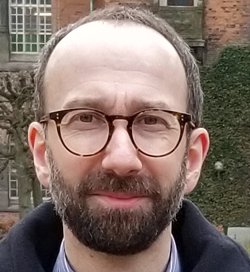 Sándor Beniczky MD PhD is board-certified neurologist, clinical neurophysiologist and epileptologist. He is professor at Aarhus University Hospital, and he is the head of the Clinical Neurophysiology Department at the Danish Epilepsy Centre. He is editor-in-chief of Epileptic Disorders, member of the Education Council, Congress Council, Big Data Council and Publication Council of the ILAE, and past-chair of the joint EEG taskforce of the IFCN and ILAE. The main research interest of Professor Beniczky is EEG and epilepsy, focusing on electromagnetic source imaging, seizure detection, standardisation and quality-assurance in clinical neurophysiology. He has supervised 11 Ph.D. students. He is author of over 200 peer-reviewed papers and 22 book chapters.
Sándor Beniczky MD PhD is board-certified neurologist, clinical neurophysiologist and epileptologist. He is professor at Aarhus University Hospital, and he is the head of the Clinical Neurophysiology Department at the Danish Epilepsy Centre. He is editor-in-chief of Epileptic Disorders, member of the Education Council, Congress Council, Big Data Council and Publication Council of the ILAE, and past-chair of the joint EEG taskforce of the IFCN and ILAE. The main research interest of Professor Beniczky is EEG and epilepsy, focusing on electromagnetic source imaging, seizure detection, standardisation and quality-assurance in clinical neurophysiology. He has supervised 11 Ph.D. students. He is author of over 200 peer-reviewed papers and 22 book chapters.
Abstract: Algorithms and artificial intelligence in epilepsy and electroencephalography
Algorithms, artificial intelligence (AI) and decision support systems bear the potential for addressing unmet needs in medicine: provide important clinical information in underserved areas (where expertise is not available) and decrease the workload in specialized centers (where expertise is available). My talk will review our research on development, validation and application of algorithms and decision support systems in epilepsy and electroencephalography (EEG). I will discuss different strategies for development of algorithms (based on principles derived from human experts, vs. algorithm developed using AI) and different strategies for clinical implementation (fully automated vs. hybrid / semi-automated systems). The talk will cover the following, main areas: epilepsy diagnosis / classification, optimal choice of antiseizure medication tailored to the individual patient, automated and semi-automated detection of seizures and interictal epileptiform EEG discharges, and automated clinical EEG reading.

Jan Bjaalie, M.D., Ph.D., is Professor at the Institute of Basic Medical Sciences, University of Oslo, where he leads a team of researchers, data curation scientists, and software developers contributing to the building of the EBRAINS RI, the European distributed research infrastructure for brain and brain-inspired research. He is Infrastructure Director of the EU Human Brain Project, leader of the EBRAINS Data services, special advisor on neuroinformatics for the EBRAINS AISBL, Head of the Norwegian Neuroinformatics Node, and former Head of the Institute of Basic Medical Sciences at the University of Oslo (2009 - 2016). With a strong background in neuroanatomy and neuroscience, he is focused on making scientific research data more accessible and interpretable and on developing advanced brain atlasing tools for brain-wide analysis of multimodal data. In his role as founding Executive Director of the International Neuroinformatics Coordinating Facility (2006 – 2008), he initiated INCF programs on brain atlasing and multi-scale modeling. Professor Bjaalie has been partner and coordinator of several EU projects and has collaborated extensively with leading laboratories in many countries. He is Chief-Editor of Frontiers in Neuroinformatics and has served as member of the Neuroinformatics Committee of the Society for Neuroscience (2004 - 2009) and co-Chair (2018 - 2020) and Chair (2021) of the International Brain Initiative.rate ultra-high resolution human brain models.
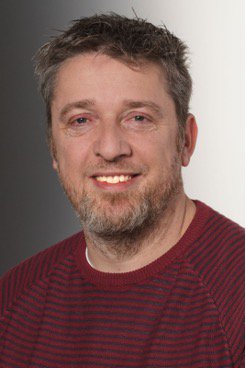
Sebastian Bludau graduated with a diploma as a biologist at the Heinrich-Heine University in Duesseldorf and received a PhD in theoretical medicine from the RWTH Aachen University in 2011, where he studied the cytoarchitecture of the frontal pole of the human brain. Subsequently he became post-doc at the INM-1 (Structural and functional organization of the brain) at the Institute of Neuroscience and Medicine at the research center Juelich. Sebastian Bludau’s current research is mainly about the cytoarchitecture of the human brain, the integration of different imaging modalities into high resolution reference spaces, high-throughput optical microscopy and developing and testing of new prototype software for the analysis of histological images.
Abstract: Using the atlas to analyze the brain
Understanding how the brain works is one of the grand challenges in science and requires the integration of huge amounts of heterogeneous and complex data. Numerous research publications present experimental data at various levels of granularity and describe a wide range of structural and functional aspects of the brain. In this context, reference atlases of the brain are important tools for assigning location to data captured with the many methods and instruments used to study the brain. With a new generation of three-dimensional digital reference atlases, new solutions for integrating and disseminating brain data are being developed. During the talk possibilities will be shown to explore brain regions in an interactive 3D viewer. Furthermore, it will be presented how to access linked multimodal data features from the EBRAINS Knowledge Graph with published and freely available tools. The steps and tools shown will be applied in practice in the afternoon hands-on session "Browsing reference atlases online".
More information will follow.
 Dr. Andrew Davison is a senior research scientist in the Department of Integrative and Computational Neuroscience of the Paris-Saclay Institute of Neuroscience (CNRS/Université Paris-Saclay), France, where he leads the Neuroinformatics research group. After completing a BA in Physics at the University of Cambridge, he gained a master’s degree in Medical Physics and Clinical Engineering at the University of Sheffield and trained as a Medical Physicist before returning to Cambridge for a PhD in computational neuroscience, which was awarded in 2001. After postdoctoral fellowships at Yale University and the UNIC laboratory of the CNRS, he obtained a permanent research scientist position with the CNRS in 2006, and started his own research group within UNIC in 2010.
Dr. Andrew Davison is a senior research scientist in the Department of Integrative and Computational Neuroscience of the Paris-Saclay Institute of Neuroscience (CNRS/Université Paris-Saclay), France, where he leads the Neuroinformatics research group. After completing a BA in Physics at the University of Cambridge, he gained a master’s degree in Medical Physics and Clinical Engineering at the University of Sheffield and trained as a Medical Physicist before returning to Cambridge for a PhD in computational neuroscience, which was awarded in 2001. After postdoctoral fellowships at Yale University and the UNIC laboratory of the CNRS, he obtained a permanent research scientist position with the CNRS in 2006, and started his own research group within UNIC in 2010.
His research interests focus on biologically detailed modelling of neuronal networks (particularly the mammalian visual system), and on developing tools to improve the reliability, reproducibility, and efficiency of biologically realistic simulations.
Abstract: Computational neuroscience with EBRAINS
The EBRAINS digital research infrastructure provides a large suite of tools for computational neuroscience, covering model building, simulation, model validation, and model/data sharing, at scales from subcellular to whole-brain. This talk will give an overview of the available tools, and of the benefits of using the EBRAINS infrastructure.
Xiao Gui graduated with a Bachelor of Science and a PhD in medicinal bioinorganic chemistry at the University of Sydney, Australia, studying the mechanisms targeting tumour microenvironments. Currently, he works at the INM-1 (Structural and functional organization of the brain) as a software developer, focusing on the development, testing and maintenance of brain atlas softwares.
 Viktor Jirsa is Director of the Inserm Institut de Neurosciences des Systèmes at Aix-Marseille-Université in Marseille, France. Dr. Jirsa received his PhD in 1996 in Theoretical Physics and Applied Mathematics and has since then contributed to the field of Theoretical Neuroscience, in particular through the development of large-scale brain network models based on realistic connectivity. His work has been foundational for network science in medicine with translations to clinical applications. Dr. Jirsa serves as scientific lead of the brain simulation platform The Virtual Brain and lead investigator in the Human Brain Project. Dr. Jirsa has been awarded several prizes for his research including the Grand Prix de Recherche en Provence (2018) and has published more than 160 scientific articles.
Viktor Jirsa is Director of the Inserm Institut de Neurosciences des Systèmes at Aix-Marseille-Université in Marseille, France. Dr. Jirsa received his PhD in 1996 in Theoretical Physics and Applied Mathematics and has since then contributed to the field of Theoretical Neuroscience, in particular through the development of large-scale brain network models based on realistic connectivity. His work has been foundational for network science in medicine with translations to clinical applications. Dr. Jirsa serves as scientific lead of the brain simulation platform The Virtual Brain and lead investigator in the Human Brain Project. Dr. Jirsa has been awarded several prizes for his research including the Grand Prix de Recherche en Provence (2018) and has published more than 160 scientific articles.
Abstract: Personalized brain modeling using the high-resolution atlas
Over the past decade we have demonstrated that the fusion of subject-specific structural information of the human brain with mathematical dynamic models allows building biologically realistic brain network models, which have a predictive value, beyond the explanatory power of each approach independently. The brain atlas play a pivotal role by establishing the reference space, in which the models are defined. Our hybrid approach fuses data-driven with forward-modeling-based techniques and has been successfully applied to explain healthy brain function and clinical translation including aging, stroke and epilepsy. Here we illustrate the workflow along the example of epilepsy: we reconstruct personalized connectivity matrices of human epileptic patients using Diffusion Tensor weighted Imaging (DTI). Subsets of brain regions generating seizures in patients with refractory partial epilepsy are referred to as the epileptogenic zone (EZ). During a seizure, paroxysmal activity is not restricted to the EZ, but may recruit other healthy brain regions and propagate activity through large brain networks. The identification of the EZ is crucial for the success of neurosurgery and presents one of the historically difficult questions in clinical neuroscience. The application of latest techniques in Bayesian inference and model inversion, in particular Hamiltonian Monte Carlo, allows the estimation of the EZ, including estimates of confidence and diagnostics of performance of the inference. The example of epilepsy nicely underwrites the predictive value of personalized large-scale brain network models. The workflow of end-to-end modeling is an integral part of the European neuroinformatics platform EBRAINS and enables neuroscientists worldwide to build and estimate personalized virtual brains.
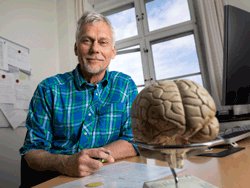 Kasper Jørgensen is a Danish neuropsychologist with a special interest in development and validation of neuropsychological tests and instruments. He is an experienced clinical neuropsychologist and is currently employed as a senior neuropsychological consultant at the Danish Dementia Research Centre at Rigshospitalet.
Kasper Jørgensen is a Danish neuropsychologist with a special interest in development and validation of neuropsychological tests and instruments. He is an experienced clinical neuropsychologist and is currently employed as a senior neuropsychological consultant at the Danish Dementia Research Centre at Rigshospitalet.
Recently he and colleagues developed the Brief Assessment of Impaired Cognition (BASIC) and the Brief Assessment of Impaired Cognition Questionnaire (BASIC-Q) case-finding instruments which were validated in a memory clinic setting in 2018-2019 and are currently being validated in a general practice setting. BASIC-Q is currently being implemented in the Copenhagen Municipality and we plan to implement BASIC in general practice in Denmark from 2023 onwards.
Abstract: A clinical perspective on memory testing
Assessment of learning and memory is essential in the clinical diagnosis of neurocognitive disorders such as dementia and mild cognitive impairment. Valid memory tests must have high sensitivity, specificity, and reliability. The role of test design in the diagnosis of neurocognitive disorders has been debated in recent decades. Tests that rely on category cued learning and recall generally demonstrate higher discriminative validity than traditional tests relying on simple memorization. Studies indicate that a decline in cued recall is a valid predictor for progression from a cognitively healthy stage to dementia years later. The presentation will focus on memory tests using category cued learning and recall adapted for clinical neuropsychological testing and for brief and accurate case-finding in a memory clinic setting and general practice setting.
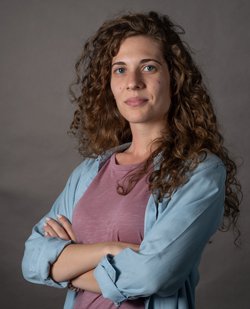 Sofia Karvounari graduated from the Department of Informatics and Telecommunications (DIT) at National and Kapodistrian University of Athens in 2016. She is currently completing her thesis for the master's degree in “Computing systems: Software and Hardware” at the Department of Informatics and Telecommunications (DIT) in National and Kapodistrian University of Athens.
Sofia Karvounari graduated from the Department of Informatics and Telecommunications (DIT) at National and Kapodistrian University of Athens in 2016. She is currently completing her thesis for the master's degree in “Computing systems: Software and Hardware” at the Department of Informatics and Telecommunications (DIT) in National and Kapodistrian University of Athens.
She has been working for the Medical Informatics Platform (MIP) of Human Brain Project - SGA2 for 2 years as a DevOps engineer. In 2020, she has been one of the first members from “Athena Research and Innovation Center in Information, Communication and Knowledge Technologies” to compose the Technical Coordination team at Human Brain Project – SGA3. Part of her responsibilities are understanding the core of the project, alleviating any problems in the continuation of it, and connecting different teams with respect to one’s needs and requirements and other’s provided value. She is actively working on minimizing the gap between Neuroscientists’ valuable scientific work with Information Technology (IT) and the complex powerful underlying infrastructure needed by introducing “Standardized computational workflows” at EBRAINS.
 Gitte Moos Knudsen is a Denmark translational neurobiologist and clinical neurologist, and Clinical Professor and Chief Physician at the Department of Clinical Medicine, Neurology, Psychiatry and Sensory Sciences, at Copenhagen University Hospital. She graduated from Lyngby Statsskole, just north of Copenhagen, before gaining entrance to medicine, where she received her MD from University of Copenhagen in 1984, and became a Board certified user of radioisotopes in 1986. She sat the FMGEMS exam (Foreign Medical Graduates Examination in the Medical Sciences) (US) in 1989. She became Board certified in neurology in 1994 and received her DMSc (Dr.Med.) from University of Copenhagen in 1994.
Gitte Moos Knudsen is a Denmark translational neurobiologist and clinical neurologist, and Clinical Professor and Chief Physician at the Department of Clinical Medicine, Neurology, Psychiatry and Sensory Sciences, at Copenhagen University Hospital. She graduated from Lyngby Statsskole, just north of Copenhagen, before gaining entrance to medicine, where she received her MD from University of Copenhagen in 1984, and became a Board certified user of radioisotopes in 1986. She sat the FMGEMS exam (Foreign Medical Graduates Examination in the Medical Sciences) (US) in 1989. She became Board certified in neurology in 1994 and received her DMSc (Dr.Med.) from University of Copenhagen in 1994.
 Eleni Mathioulaki is a computer engineer at the Information Management Systems Institute of Athena Research Center in Information, Communication and Knowledge Technologies. She received her Integrated Master’s degree as an Electrical Engineer and Computer Engineer from the National Technical University of Athens, Greece in 2020, with a specialization in Computer Systems and Software, Signals, Control and Robotics. Her research interests include Machine Learning, Computer Vision, Data Science and Biomedical Engineering. For the past year she has been a member of the Technical Coordination team of the Human Brain Project, mostly working on understanding the requirements of scientists, developers, and end-users of EBRAINS, coordinating their efforts and providing solutions. Currently, her main focus is the standardization of computational workflows within EBRAINS, to enable the reuse and reproducibility of scientific research.
Eleni Mathioulaki is a computer engineer at the Information Management Systems Institute of Athena Research Center in Information, Communication and Knowledge Technologies. She received her Integrated Master’s degree as an Electrical Engineer and Computer Engineer from the National Technical University of Athens, Greece in 2020, with a specialization in Computer Systems and Software, Signals, Control and Robotics. Her research interests include Machine Learning, Computer Vision, Data Science and Biomedical Engineering. For the past year she has been a member of the Technical Coordination team of the Human Brain Project, mostly working on understanding the requirements of scientists, developers, and end-users of EBRAINS, coordinating their efforts and providing solutions. Currently, her main focus is the standardization of computational workflows within EBRAINS, to enable the reuse and reproducibility of scientific research.
 I graduated in Psychology in the University Miguel-Hernandez (Alicante, Spain) and went on to specialise in Circuits Neuroscience, obtaining a PhD in Biomedical Sciences from the University of Edinburgh (U.K.) in 2017. During my PhD, I studied brain-wide activity propagation of frequency-dependent information that arises from the hippocampus, using a combination of in vivo electrophysiological recordings, deep-brain electrical micro-stimulation, and functional magnetic resonance imaging. I was always extremely interested in the field of learning and memory, and the mechanisms by which the brain deals with the processing of information. Now, I’m an assistant professor at Aarhus University where I’ve focused my research in the cellular and physiological mechanisms underlying forgetting and their manipulation. For this, I use rodent models and a combination of in vivo techniques for neuronal activity manipulation (i.e., optogenetics), electrophysiological recordings and behavioural studies.
I graduated in Psychology in the University Miguel-Hernandez (Alicante, Spain) and went on to specialise in Circuits Neuroscience, obtaining a PhD in Biomedical Sciences from the University of Edinburgh (U.K.) in 2017. During my PhD, I studied brain-wide activity propagation of frequency-dependent information that arises from the hippocampus, using a combination of in vivo electrophysiological recordings, deep-brain electrical micro-stimulation, and functional magnetic resonance imaging. I was always extremely interested in the field of learning and memory, and the mechanisms by which the brain deals with the processing of information. Now, I’m an assistant professor at Aarhus University where I’ve focused my research in the cellular and physiological mechanisms underlying forgetting and their manipulation. For this, I use rodent models and a combination of in vivo techniques for neuronal activity manipulation (i.e., optogenetics), electrophysiological recordings and behavioural studies.
Synaptic depotentiation and forgetting: understanding and manipulating memory decay
The cellular and molecular mechanisms of natural forgetting are largely unknown, but understanding these processes would open new avenues for clinical applications. We have investigated the relationship of the synaptic mechanism of depotentiation with the behavioural expression of memory decay in rodent models. Using a combined approach of optogenetics, electrophysiology and pharmacological manipulations, we propose a way to observe and interact with forgetting mechanisms in a controlled environment which opens new avenues for the study of memory decay.
 Petra Ritter heads the Brain Simulation Section at the Charité University Medicine Berlin and Berlin Institute of Health. Her research focus is on integrating neuroimaging and computational neuroscience to discover mechanisms of brain function and dysfunction. She serves in the leadership of large EU projects such as Virtual Brain Cloud & eBRAIN-Health and is directing EBRAINS Health Data Cloud. Petra Ritter studied medicine at the Charite where she later had been appointed a Johanna Quandt lifetime Professorship for Brain Simulation. Since 2017, she is Director of the Brain Simulation Section at Charité Universitätsmedizin Berlin.
Petra Ritter heads the Brain Simulation Section at the Charité University Medicine Berlin and Berlin Institute of Health. Her research focus is on integrating neuroimaging and computational neuroscience to discover mechanisms of brain function and dysfunction. She serves in the leadership of large EU projects such as Virtual Brain Cloud & eBRAIN-Health and is directing EBRAINS Health Data Cloud. Petra Ritter studied medicine at the Charite where she later had been appointed a Johanna Quandt lifetime Professorship for Brain Simulation. Since 2017, she is Director of the Brain Simulation Section at Charité Universitätsmedizin Berlin.
Abstract: EBRAINS “Twins": Actionable Multilevel Health Data
The public health crisis emphasizes the need for better exchange and access to different types of health data. Health and resilience have multiple determinants, each often studied by a different discipline - spotlighting the need for merging disciplinary boundaries and fostering an interconnected community. With EBRAINS Health Data Cloud we spark engagement for a transparent data system that protects citizens’ data and facilitates their use for healthcare and research. The goal is a distributed research platform for modeling and simulating complex neurobiological phenomena of human brain function and dysfunction in a data protection compliant environment. The Health Data Cloud will provide thousands of multilevel virtual brains - the EBRAINS “twins" from patients and healthy human controls for research and innovation. Brain data from multiple sources will be pre-processed and annotated with a common data model - such that they all will relate to common spatial and temporal reference frameworks. The platform thus offers a next generation clinical research infrastructure - compliant with the EU General Data Protection Regulations (GDPR) and creates an open yet protected space for groundbreaking digital health innovation by the research infrastructure communities comprising academia and the private sector.
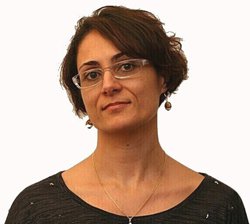 Assoc. Prof. Silvia Tolu currently leads the Neurorobotics team at the Technical University of Denmark (DTU). She holds a Ph.D. degree in Neuromorphic Computing from the University of Granada (Spain). Her main research experience is in bio-inspired control for robots, compliant human-robot interactions, computational models of the cerebellum, and machine learning. Her research focuses on developing brain-based methods and technologies for enabling autonomy in robots while they act in realistic, dynamic, and rich sensory environments. Her vision is to open revolutionary robotics paradigms and to discover novel methods for diagnosis and rehabilitation of neuro-degenerative diseases. In 2016, she was granted with an IF-EF H2020 Marie Sklodowska-Curie Fellowship (BIOMODULAR, Project ID: 70510 2017-2019). She has been principal investigator in the Co-Design Project 2 (CDP2 Human Brain Project HBP-SGA2) about cerebellar implementations in robotic systems (2018-2020). Silvia has published in influential journals and proceedings in both robotics and computational neuroscience and has served as reviewer for top-ranked conferences and journals. She is currently in the Editorial Board of Frontiers Neurorobotics.
Assoc. Prof. Silvia Tolu currently leads the Neurorobotics team at the Technical University of Denmark (DTU). She holds a Ph.D. degree in Neuromorphic Computing from the University of Granada (Spain). Her main research experience is in bio-inspired control for robots, compliant human-robot interactions, computational models of the cerebellum, and machine learning. Her research focuses on developing brain-based methods and technologies for enabling autonomy in robots while they act in realistic, dynamic, and rich sensory environments. Her vision is to open revolutionary robotics paradigms and to discover novel methods for diagnosis and rehabilitation of neuro-degenerative diseases. In 2016, she was granted with an IF-EF H2020 Marie Sklodowska-Curie Fellowship (BIOMODULAR, Project ID: 70510 2017-2019). She has been principal investigator in the Co-Design Project 2 (CDP2 Human Brain Project HBP-SGA2) about cerebellar implementations in robotic systems (2018-2020). Silvia has published in influential journals and proceedings in both robotics and computational neuroscience and has served as reviewer for top-ranked conferences and journals. She is currently in the Editorial Board of Frontiers Neurorobotics.
Abstract: From Computational Neuroscience to Autonomous Robotics and back
Computational brain models interfaced with robots (neuro-robots) allow reproducing human capabilities and getting insights into the neural mechanisms underlying behaviour. This talk will present some bio-inspired adaptive control systems applied for autonomous robotics. Neuro-robots become able to learn and adapt their tasks with small amount of priori knowledge in changing scenarios thanks to their growing brain skills. The results represents a step closer towards a better understanding of the underlying neural mechanisms for motor control and learning, but also the starting point for achieving collaborative robots acting in complex applications such as manufacturing, assistive living, or as a tool for discovering the root causes of neurodegenerative diseases.
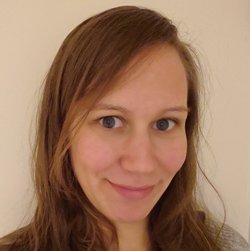 Maaike van Swieten obtained her PhD in clinical neurosciences from the University of Oxford, where she also helped set up a departmental data sharing platform. She is currently working as a data curation scientist in the EBRAINS Data and Knowledge Team. Using her broad neuroscience background working with human, non-human subjects and computational models, she is giving expert advise on data sharing according to the FAIR guiding principles. Maaike is passionate about advancing open science. She (co-)develops educational training material on data management and data sharing, and is a member of the International Brain Initiative’s Data Sharing and Standards Training Task Force.
Maaike van Swieten obtained her PhD in clinical neurosciences from the University of Oxford, where she also helped set up a departmental data sharing platform. She is currently working as a data curation scientist in the EBRAINS Data and Knowledge Team. Using her broad neuroscience background working with human, non-human subjects and computational models, she is giving expert advise on data sharing according to the FAIR guiding principles. Maaike is passionate about advancing open science. She (co-)develops educational training material on data management and data sharing, and is a member of the International Brain Initiative’s Data Sharing and Standards Training Task Force.
Scientific Chair
Katrin Amunts | Forschungszentrum Jülich/Heinrich-Heine-Universität Düsseldorf (Scientific Research Director HBP)
Programme
Committee
Katrin Amunts | Forschungszentrum Jülich/Heinrich-Heine-Universität Düsseldorf, Germany (Scientific Research Director HBP)
Caroline Ernoult | EBRAINS, Belgium
Tabea Kirchner | Forschungszentrum Jülich, Germany
Celia Kjærby | University of Copenhagen, Denmark
Trine Lisberg Toft | University of Copenhagen, Denmark
Gitte Moos Knudsen | Copenhagen University Hospital, Denmark
Elias Najarro | IT University of Copenhagen, Denmark
Paschal Ochang | De Montfort University, United Kingdom
Nicolas C. Petersen | University of Copenhagen, Denmark
Sabine Ruland | Forschungszentrum Jülich, Germany
Philippe Ryvlin | Centre Hospitalier Vaudois, Switzerland
Local Hosts
Celia Kjærby | University of Copenhagen
Trine Lisberg Toft | University of Copenhagen
Nicolas C. Petersen | University of Copenhagen
Supported by

In Collaboration with
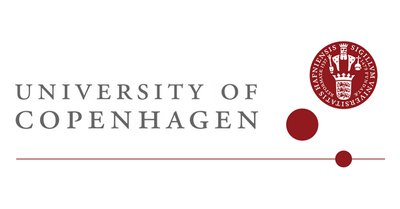

Contact
Venue
University of Copenhagen
Faculty of Health and Medical Sciences
Maersk Tower
Blegdamsvej 3B
2200 Copenhagen

